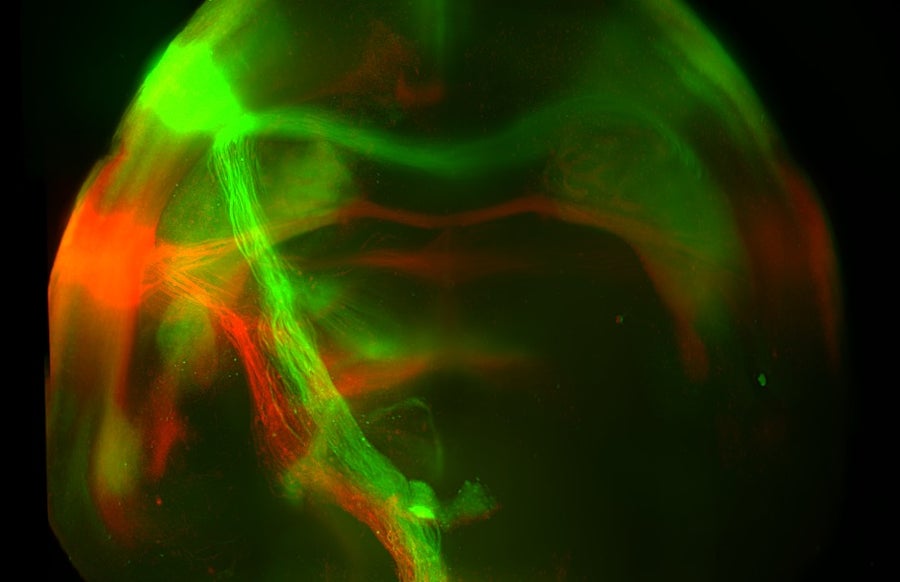Imagine if we could rewire our brains so that tastes we usually crave became unpleasant—or even nullify responses to taste completely. New research from a group led by neuroscientist Charles Zuker of Columbia University’s Zuckerman Institute suggests this may be possible. The research shows the brain is hardwired to generate responses to specific tastes, and the resulting feelings of pleasure or revulsion separate out from the qualities of tastes that allow us to identify them. Knowledge of this circuitry might eventually allow scientists to “switch off” a craving for sweets by altering or blocking these responses.
Zuker's group has previously shown that receptors on the tongue that respond to one of the five tastes—sweet, bitter, salty, sour and umami—send signals to specific parts of the cortex, the brain's outermost region responsible for higher cognitive functions. Different areas of the taste, or gustatory, cortex receive inputs from different types of receptors, creating dedicated regions for each taste. Directly stimulating these neurons using light-sensitive proteins activated via fiber-optic cables—a technique called optogenetics—causes mice to behave as though they are experiencing specific tastes. “Simply activate a few hundred cells in the bitter cortex and the animal not only thinks it’s tasting bitter but executes all the associated behaviors, including gagging, cleaning its mouth and so forth,” Zuker says. “The message from that was taste is really in your brain.”

Neural projections from the sweet (green) and bitter (red) cortex terminate at distinct targets in the amygdala in the brains of mice. Credit: Li Wang, Zuker Lab and Columbia’s Zuckerman Institute
On supporting science journalism
If you're enjoying this article, consider supporting our award-winning journalism by subscribing. By purchasing a subscription you are helping to ensure the future of impactful stories about the discoveries and ideas shaping our world today.
The new study, published Wednesday in Nature, builds on these findings to delve deeper into the brain’s taste circuitry. The researchers genetically engineered mice to produce fluorescent proteins in neurons—green in the sweet cortex, red in the bitter cortex. They then traced the connections emanating from these cells to other regions. They were especially interested in the amygdala, a brain structure involved in processing emotion and assigning positive or negative values, or valence, to sensory input. The specialization in different areas of the cortex was remarkably preserved—sweet cells connected primarily to an area called the anterior basolateral amygdala whereas bitter cells mainly linked to the central amygdala. “This elegant study provides new insight into the architecture of positive and negative valence in taste,” says neuroscientist Kay Tye of The Picower Institute for Learning and Memory at Massachusetts Institute of Technology, who was not involved in the study. “The segregation of sweet and bitter [connections] across different amygdalar nuclei was stunning.”
Sweet is an inherently attractive taste that induces appetitive behaviors (like scarfing down entire chocolate cakes) whereas bitter is inherently unpleasant. “Bitter tastes typically signal poisons while sweet tastes typically signal calorically dense foods,” Tye says. The researchers reasoned that the connections they had revealed might underlie the amygdala’s role in assigning valence to tastes, which then drives behavior. To test this, they used optogenetics to make either sweet or bitter connections into mice’s amygdalae activate in response to light. Switching on sweet connections caused mice to prefer a cage whereas those with activated bitter connections avoided it. An experiment in which light switched on the sweet circuit when mice drank water spurred the animals to drink furiously whereas bitter connections suppressed drinking. Activating cells in the mice’s amygdalae was enough to make neutral-tasting water either appealing or aversive. The team then wondered whether it was possible to override responses normally provoked by appealing or aversive tastes. To investigate, they gave mice a bitter chemical (quinine) or a sweet solution (the artificial sweetener AceX), and then monitored drinking behavior while activating their amygdalar connections. Activating sweet connections caused mice drinking quinine to drink more, activating bitter ones turned the normally appealing sweet taste into a horrible one. These results show the amygdala is central to determining the valence of tastes. “It’s a unique example of a hardwired, predetermined circuit that evolutionarily most likely served a simple requirement,” Zuker says, “which is: I need to know what’s essential for me to maintain my dietary needs and not be poisoned and die.”
The researchers hypothesised that if different brain regions are responsible for imposing different features of the sense of taste, it might be possible to dissociate them. “We thought it should be possible to have the taste of sweet without being attracted,” Zuker says. “Conversely I should be able to give you a bitter—and you know that you’re tasting something bitter but be completely blind to its innate aversive features.” To investigate, they conducted another set of experiments in which they blocked amygdalar activity, either genetically or with a drug. They first showed this both abolished the effects of directly stimulating cortical taste neurons on appetitive and aversive behaviors, and dramatically reduced these behaviors in response to real tastes. They then trained mice to identify tastes and the final experiment showed that silencing the amygdala has no effect on their ability to perform this task, despite the profound effect it has on reducing their responses to the same tastes. This finding implies different components of taste experiences are dissociable and can be independently modified, or even removed. “This study separates the identification of tastes from their valence,” Tye notes, “which could be key to understanding how we can learn to like beer or coffee, and why we’re capable of finding cake frosting disgusting if we’ve previously been sick from eating it.”
This is fundamental research with no immediate clinical relevance, but it could ultimately have implications for researchers looking to treat people with severe obesity problems by blocking certain responses to certain tastes. There may even be implications for understanding eating disorders because food’s valence may be connected to the guilt experienced in conditions like anorexia. Zuker, meanwhile, is motivated by understanding what he calls the “symphony” of sensory experiences. “As we probe deeper into the brain, we begin to see this remarkable distributive organization of tasks,” he says. “Information gets to key hubs—the conductor of the orchestra—then gets distributed to the right players to execute the right behaviors.” He plans to continue probing this circuitry, to try to understand how the brain links taste with context, value, emotions, memories, thoughts and behavior. “I use taste as a window into the brain; it has extraordinary power to transport you back to a different experience,” he says. “If we can follow the signal, we can begin to uncover how the brain manages to choreograph this.”
